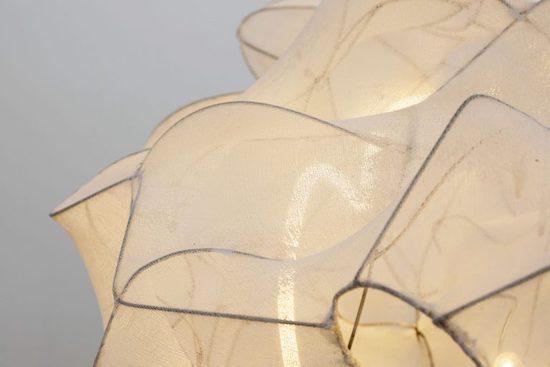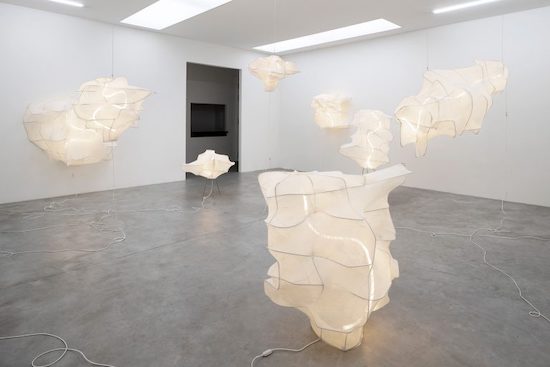Frederik Nystrup-Larsen is a young artist based between Copenhagen and London. Listed in the New York Times emerging artists to watch for 2018, he has produced a large body of work in a short time – inspired by communication and collaboration.
For me, his work seems to be about balance. It’s engaged with themes of exchange and compromise between the viewer, the work, and the space. Whilst some works of art may aim to consume a room, to grab the viewer and pull them in, Nystrup-Larsen’s practice does not. His works provide space for the viewer. They provide space for the space. It’s the unspoken, unintentional interaction that comes with these works that imbue them with a sense of honesty. He does not make works which feel insistent, nor submissive; they are open.
In January 2018, Soft Boxing marked Eighteen’s first exhibition of the year, a sell out show. The sister gallery of Copenhagen’s V1, it offered a white cube ideal for the artist and collaborator Oliver Sundqvist to install a series of delicate sculptural works, suspended, floating in the space.
In this interview we touch on themes of honesty, interaction, and dialogue within the work and his broader practice.
How was the show at eighteen? The photos look great.
It was so nice. It’s been a lot of going back and forth but I’m happy that I managed to do all of it.
So, run me through Soft Boxing.
This is probably the project that we’ve worked on for the longest period. From the first idea, sketching what I wanted to make and the language of it, through to the production took a long time. It’s such a physical process, plus it has to have a particular relationship with space, so it was slow moving at first. It’s the kind of work where you have to go back and forth over a period of time but I actually thought that this experience was really nice. It ended up very close to what I intended, or imagined it to be from the first sketches.
Also, Eighteen is an amazing space. Working in this white cube was so giving to the project – we started with this space in mind so the project has really always lived in this space. Going through convincing the gallery that we were supposed to do it here, then supposed to do it now was all part of what gave life to the work. The experience with the show has been really great.
It’s probably the same in London but in Copenhagen, galleries can be quite conservative. It was a risk for them to give a solo show to us but in my opinion, it was a great experience.
For me a lot of your work seems driven by negotiation. You don’t have a particularly forceful practice. Your work is about the dialogue between making and work and space. From visiting your studio and seeing the clay works, to now seeing Soft Boxing, I think this idea of relationship is very interesting. With Soft Boxing, you had the opportunity to be quite manipulative of the space, it can sometimes be tempting to sort of overrun these space or exercise control. For me, Soft Boxing is more of a collaboration with space, it generates a very relaxed exhibition.
Your practice seems to be motivated by dialogue at every step, from you and Oliver Sundqvist through to the fabricators involved in helping to put the work together, the curators and the space it ends up in – there’s a really interesting idea of communication and relationships here. It was interesting, even with the work you were showing at the RCA show. It wasn’t an attempt to turn the studio into a gallery. It was work very much aware of it being in a studio setting.
It’s interesting talking to certain artists – everything is like a problem for them, you know? There was a piece of text for the exhibition, like an instructional text. The only kind of argument we’ve had installing Soft Boxing was over where to put this text. I talk to artists who say “Fuck it! Put it where you want” but this isn’t the way I like to work. It’s important for me that the gallery has a pleasant experience working with us. It affects the atmosphere in the space. Everyone was so happy with the result, that means much more to me than putting my foot down over something. It creates a better atmosphere in the space and I like this dialogue existing in the work.
Tell me a little bit about the collaborative process in your work? It seems like this collaboration with Oliver is indicative of a broader notion of consensus present in your practice. Even with the clay pieces you were showing recently, them being unfired is a sort of metaphor for this. They are allowed to exist in their current state, they’re unfired, saving the material this undue stress but also allowing the marks of making and its materiality to be very visible.
It’s cool, if I come up with an idea and share it with Oliver he will say “Yeah, the idea is cool… but maybe we should do it this way instead?” which allows things to grow. Plus there are technical things, making, the dialogue between us is also the sharing of skills.
When we made Soft Boxing, we had textiles and metal frames. We worked together with a fabricator who would do the sewing of the fabrics and she had a lot of input as well. Something like how the fabric should be sewn has a significant impact on the aesthetic outcome of the work and this is something that we were interested in.
There were also other material negotiations: The welding began to rust and this rust would begin to colour the fabric. Of course I could have spent time removing these stains and attempting to restore the fabric but for me this was not important. I like the honesty of this. It may not have been exactly what I intended but I wouldn’t want to change it. I’m happy with the outcome. I’m looking for this honesty in all pieces.
That’s part of what makes an artist, this negotiation with materials. We were talking recently about living in London and seeing so many artist-led shows embracing new media, that has a very different kind of artistic fingerprint. There are still happy accidents, of course but I think it’s something quite different from the tenderness communicated in your recent works. The making is very visible in them, it’s very clear how they come to be. They have evidence of error but this error is part of what makes them feel human.
I think it is highly typical of our time. What I feel with the work, and what I hope others see in this work, is a level of honesty. There’s an element of craft which is not present in something like a VR work in that you can see the process by which they were made, I think people need this in our time. Everyone seems to be so consumed by digitalisation and not having any relationships to anything. You see it in everything, with so much art including things like plants or flowers in order to include a tactile element that is recognisable and to tether them to the real world.

Do you see a risk in making works like this? They’re difficult to transport and require a particular level of care. I’m thinking of your clay works that we saw in the studio, particularly in that they require specific space, temperature etc. or they will begin to breakdown. Is that intentional or symptomatic of their making?
It’s part the negotiation, and something that I talk with the galleries about. What would have happened to the works if we didn’t sell all of them? Where would they go? Part of the work is finding the right place for the works to go, how they get there and the situation in which they live afterwards. I was talking with some of the collectors who bought the work and saying something like, “I would be so grateful if you would allow me to come and install the work, or help to install the work” because I feel that it’s important that the pieces are situated in the correct space. I think it’s a good part of the experience. I don’t see it as a problem, it’s just something that happens.
I definitely like to think about the afterlife of the work. With the propagation of images, mostly digital, the work can end up in the wrong space. It can ruin the work, or ruin your idea of how it’s supposed to be. We try to do a look book for every show because we want it to not be misunderstood. We try to be selective about who gets hold of the photos, you can’t control this but we like to try.
That’s interesting because this dialogue and problem solving seems constantly present in your practice but the problems only seem to occur when the communication stops – when the images and works move around without discussion.
Of course – but it’s out of my hands. I try to think of it because this work is so in-between being a functional object and a more traditional art piece. I have this feeling that it’s okay for people to use it in whichever way they see fit, as long as they appreciate it. Not that I can change it.
You mentioned the text and negotiating it with the gallery. What role does writing play in your practice?
The writing for this show was really important. It was very important to me that the viewers would compare between the text and the objects. It’s not a description – it’s a work in itself. We printed it many times as A1 posters, sort of like instructions on how to behave in the room. It talked about thinking of yourself as these objects and also how the works were made.
I’m very interested in these open source ideas, I’ll tell anyone how to make these. If you want to make it, go make it – I don’t think it can ever be the same but it would amazing to see people make their own thing. I think for me the most important thing is to make work which is inspiring for people or encourages them to produce something themselves. It’s about sharing and the beauty found in that.
Soft Boxing by Frederik Nystrup-Larsen and Oliver Sundqvist is at 18, Copenhagen, until 16 February


